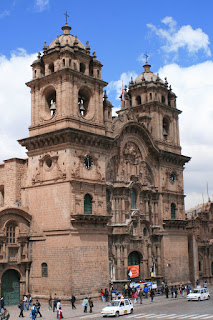
The past week was spent trying to pack Peru into a week. Impossible. Peru was excited and incredibly different from Chile. The strong influence of the ancient Quechua or Inka culture shares little resemblence to the westernized streets of Santiago. Small indigenous women, who only speek Quechua stumble up the hilly, narrow cobblestone streetes of Cusco carrying giant handwoven bags on their backs laden with crafts or food or babies. Often they are followed by their llama or alpaca, with whom they pose for pictures from tourists for a small price.
I could never have imagined the tourism in Cusco. Walking down the street I was excstatic to find a Vermont quarter on the ground, the first U.S. coin I had seen in months. Tour buses and taxis full of Gringos scream through the Plaza de Armas as they race to archeological attractions in an around the city. It is impossible to walk one block without having someone offering tours, massages, food, crafts, or just plain begging.
The history found in Cusco and the culture outweighs the annoyances of a high tourism destination. Molly and I went to many of the sights in city, which was the holy city of the Inkas before the Spanish knocked it down and built incredible churches. Outside the city lie the ruins of Saqsaywaman and other small fortresses, holy sites, and agricultural terraces. About an hour outside is the town and ruins of Pisac. On Sunday there is an impressive market in the square which is dominated by tourists but displays the incredible artisanal skills of the rural people. I was wholly impressed by these ruins, built way up on cliffs above the river and the city. We wandered and explored through the ruins for a few hours and glanced at the great views.

After exploring Cusco for several days we took a colectivo out to Ollantaytambo to catch the train, the only way to get to Aguas Calientes, or Machu Picchu Village. The train website, like most South American attempts isn't worth a damn so we ended up getting a confusing schedule and accidentally paid for one of the more expensive coaches to get there known as the Vistadome. There were six other people in our coach and we watched as the scenery changed from barren highlands into lush jungle forests.

Aguas Calientes is a testament to the awful things that tourism can do when unregulated. Its the Cancun of archeology. Sitting at the base of mountains in a small valley carved by the Urubamba river, the city has sprung up in response to the massive amounts of tourists that come through to see Machu Picchu. A multidude of restaurants line one of the two roads in town as locals call out in English, "Free Drink", "You like nacho?...Free nacho", etc. The buildings are all falling apart except for the facade on the street. The restaurants will do anything to get someone into the restaurant and then revoke the offer. We were lured by two free beers, free nachos, and a twenty percent discount which in the end they denied. I was able to bargain two free beers and two dollars off my pizza as the waiter literaly sweated at my offers. Everything is expensive and disgusting, including our hostal where we found a tarantula sitting on the steps outside the bathroom.
It's really sad because the city has such potential. The lushus green mountains are lined with dramatic cliffs that shoot upward into a canopy of clouds. The day we went up to Machu Picchu we woke up at 4 a.m. to catch the first bus up at 5:30. The line was incredible still but and as we drove up the steep switchbacks the excitement of the passangers was tangible. Unfortunately, something had taken up residence in my G.I. tract the night before and was unleashing its formidable claws upon my insides, thus rendering me sleepless and miserable. Although the pain continued for the most of the day, I was able to push it aside as the sun came up over the ruins and we were given tickets to climb Wayna Picchu, the mountain recognizably in the background of every Machu Picchu photo ever.


The ruins were otherworldly. The detail and care of every rock was astounding and the surrounding scenery breathtaking. It was easy to lay on the grassy terraces or in the giant quarry and imagine the glory of the city in its peak or the moment when Hiram Bingham first discovered the overgrown hidden ruins in the early 20th century. The hike up Wayna Picchu was steep but rewarding with ruins atop and new views of Machu Picchu that don't grace the postcards.

We stayed until the whistling guards kicked us out around 5:30 p.m., taking the last bus down to the town. In all it was a day to remember. The massive size of the sanctuary was hypnotic and a perfect way to end my traveling.


















